Carl "Charly" DegelowPour le Merite, Royal House Order of Hohenzollern, Iron Cross, was a German fighter pilot during World War I. He was credited with 30 victories, and was the last person to win the military Pour le Merite.
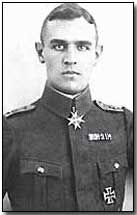
Franz Büchner PlM was one of the most successful German fighter aces of the First World War, shooting down 40 enemy aircraft. He began his military career as a 16-year-old infantryman. His doughty exploits earned him a battlefield commission just after his 18th birthday, in early 1916. After being wounded and invalided from the infantry, he joined the Imperial German Air Service. Once he progressed to become a fighter pilot flying a Fokker D.VII, he initially struggled to gain his first aerial victories. Something clicked after his fifth victory, and he began to regularly shoot down enemy airplanes, scoring 35 victories between 1 July and 22 October 1918. Most notably, he shot down four SPADs on 26 September. He survived the war, but died in action in 1920 while combating communist revolutionaries near Leipzig.
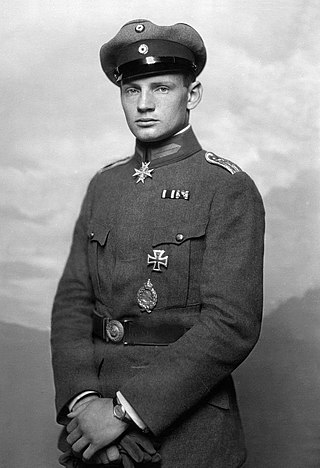
Heinrich Gontermann was a German fighter ace credited with 39 victories during the First World War.

Rittmeister Carl Bolle, PlM, MMC, HOH, IC, was a fighter ace with 36 aerial victories during World War I. He became a Jagdstaffel commander during that war, and an advisor to the Luftwaffe during World War II.
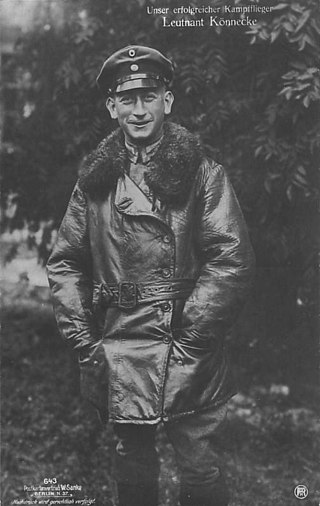
LeutnantOtto Könnecke PLM, MMC, HoH, IC, was a leading German fighter ace of World War I with 35 victories. He was one of only five pilots to receive Germany's highest decorations for both enlisted pilot and officer. He later became one of the founding pilots of Deutsche Luft Hansa and assisted in development of the new Luftwaffe.
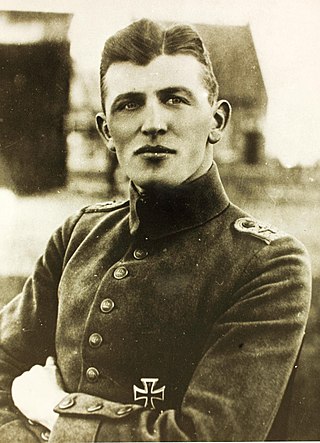
OberleutnantHenrich Claudius Kroll Pour le Merite, Knight's Cross of the Royal House Order of Hohenzollern, Saxony's Albert Order Knight Second Class with Swords, Iron Cross First and Second Class, was a World War I fighter ace credited with 33 victories.
Generalmajor Hermann Frommherz Military Order of St. Henry, Royal House Order of Hohenzollern, Knight's Cross of the Military Karl-Friedrich Merit Order, began his military career in World War I as a German ace fighter pilot. He was credited with 32 victories. During World War II he was involved in the German takeover of Czechoslovakia and rose to become a Luftwaffe Generalmajor.
Paul Billik was a German World War I fighter ace credited with 31 victories. He was killed in a flying accident while pioneering civil aviation.

Adolf Ritter von Tutschek (16 May 1891 – 15 March 1918) PlM, MOMJ was a professional soldier turned aviator. As German air strategy turned towards concentrated air power, he was entrusted with one of the world's first fighter wings.
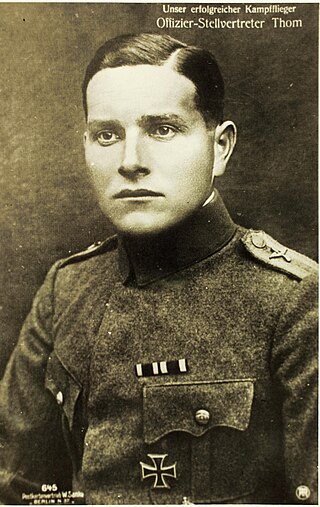
Leutnant Karl Thom, was a German World War I flying ace credited with 27 victories. He was decorated with both his nation's highest decorations for valor, the Military Merit Cross as an enlisted soldier, and the Pour le Mérite after he was commissioned as an officer. He was one of only four German aces of World War I to achieve this double award.
Leutnant Olivier Freiherr von Beaulieu-Marconnay was a German World War I ace fighter pilot credited with 25 victories. Having joined the military at age 16, his success in shooting down 13 enemy aircraft led to his being appointed to command a fighter squadron, Jagdstaffel 19, at age 19. He was credited with another dozen victories before being mortally wounded. Because Germany's highest award for valor could not be granted posthumously, it was hurriedly approved just hours before his death. He is notable for being World War I's youngest recipient of the Pour le Merite.
Leutnant Georg von Hantelmann was a German fighter ace credited with winning 25 victories during World War I. It was notable that these victories included three opposing aces shot down within the same week in September 1918–David Putnam, Maurice Boyau, and Joseph Wehner.
LeutnantHans Martin Pippart Iron Cross was a pioneer aircraft manufacturer and early pilot. As a World War I German fighter ace he was credited with 22 victories.
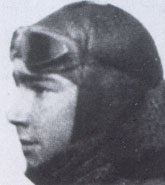
Leutnant Friedrich Friedrichs was a World War I fighter ace credited with 21 confirmed victories.
Hans-Georg von der Marwitz was a German World War I flying ace credited with 15 aerial victories.
Oberleutnant Hans Bethge HoH, IC was a German pilot who was one of the first World War I flying aces, as well as an aerial commander. He was credited with 20 aerial victories. He was also a squadron commander for the unusually long term of fourteen months.

Royal Prussian Jagdstaffel 12 was a World War I "hunting group" of the Luftstreitkräfte, the air arm of the Imperial German Army during World War I. As one of the original German fighter squadrons, the unit would score 155 aerial victories during the war, at the expense of seventeen killed in action, eight wounded in action, and one taken prisoner of war.
Royal Prussian Jagdstaffel 17 was a "hunting group" of the Luftstreitkräfte, the air arm of the Imperial German Army during World War I. As one of the original German fighter squadrons, the unit would score 101 aerial victories during the war, with another 22 of the squadron's claims going unconfirmed.
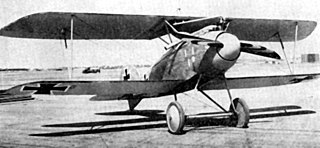
Royal Prussian Jagdstaffel 26 was a "hunting group" of the Luftstreitkräfte, the air arm of the Imperial German Army during World War I. As one of the original German fighter squadrons, the unit would score 177 verified aerial victories, including four observation balloons destroyed. The Jasta would pay a bloody price for its success: five pilots killed in action, nine wounded in action, and one prisoner of war.
Oberst Paul Aue was a World War I flying ace from the Kingdom of Saxony in the German Empire. Partial records of his early aviation career credit him with 10 aerial victories. He would join the nascent Luftwaffe during the 1930s and serve Germany through World War II. He died in a Russian prison camp in 1945.










